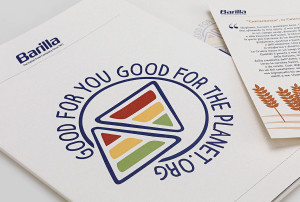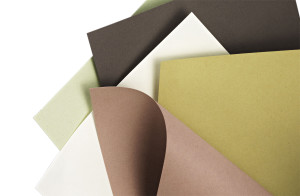Cartacrusca (i.e. bran paper) is the result of the collaboration between Favini, a long-standing producer of ecological papers, and Barilla. It is exclusively produced from bran for the famous food company.
by Clara Montani

This is an extremely interesting project, which is clearly setting off for environmental sustainability. The focus is on recovering the bran obtained from the grinding of wheat, barley, rye and other cereals to then process it, together with cellulose, and turn it into a raw material in paper production. The process does not therefore simply consist in recycling waste papers, but is rather an innovative and far-reaching project going hand in hand with environmental sustainability and implemented by Barilla , i.e. reducing the consumption of raw materials and bring a waste product back to life. The commitment towards sustainability has become one of the strengths of the food group and has translated into projects aimed at turning supply chains more environmentally friendly through the use of renewable energy sources, paperboards coming from sustainable forests, combined heat and power (CHP) installations, etc.
The resulting new projects included the idea of promoting bran, i.e. one of the by-products of wheat grinding. Among the group sales this entry is subject to the continuous oscillations due to the market fluctuations of costs, which do not guarantee certain revenues. This unstable trend is coupled with limited engagement: bran is destined for human food part, but only to a limited extent, while the other part is sold as feedstuff. The quantities concerned are relatively limited, especially if compared with a bran quantity, which is markedly higher. The need was thus felt to think of an idea about how to use and promote this by-product in a different way.
The partnership with Favini
«We were looking for a solution able to combine the group environmental philosophy and enabling us to give bran a new life at the same time», explains Giacomo Canali, Packaging Research Manager at Barilla. The manager found the answer in an article on the Favini paper mill, focussed on the productive process of Crush, (Crush paper), i.e. a brand that launched on the market in 2012. Those who not experts in the field have long talked about the Crush paper, as it has 15% cellulose less to favour the use of waste from agricultural and food productions (e.g. citrus fruits, kiwis, corn, coffee, olives, hazelnuts, almonds).

«When we saw the production process and had a proof of the quality of the Crush paper, we realized that Favini was the ideal partner for Barilla, i.e. the ideal interlocutor capable of giving us the best guarantees to implement the possibility of recovering the bran part that can no longer be used for food», says Mr. Canali.
About a year ago the Favini team and the Barilla R&D unit met to discuss the possibility to select and use the most adequate bran residue. Since then they have worked in close collaboration to eventually identify the ideal purification and micronization process to then make it compatible with the fibrous fabric of paper. Within a couple of months only this collaboration has become tangible and led to the bran paper Cartacrusca, which is a special kind of paper exclusively produced by Favini for Barilla.
Mr. Canali underlines that «we have enthusiastically worked for this project and last October Cartacrusca made its debut during the Barilla Stakeholders panel, where it was used for printing out the brochures distributed to participants».
After this initial presentation, Barilla is planning to use it for other types of products, e.g. books, recipe books, catalogues, communication and marketing activities working documents, etc.
«We very much like the idea of combining a “poor” product with prestigious editorial projects. Of course, we had to abandon the idea of using this paper for the packaging of Barilla products, because it is not suitable to come in touch with food, but we are still very proud to have succeeded, with the help of Favini, in enhancing and promoting one of our by-products. Engaging for the environment and pursuing this objective is currently one of Barilla’s main strengths. The fact that this is done by recovering a by-product that can no longer be used for food makes us really very satisfied».
Cartacrusca working process
For the production of Cartacrusca Favini replaces 17% of the cellulose derived from trees with bran, thereby achieving a naturally coloured paper whose main ingredient can be immediately perceived simply by looking at the surface of the paper. Two paper basis weights are available to best meet the needs of the group, i.e. 250 g/m2, which can be used for paperboards, covers, shopping bags and folders, and 100 g/m2 for other printed materials.
«In the production of Cartacrusca we have followed the same methodology used for the production of Crush, i.e. a brand referring to a type of paper, which in short time has been capable of meeting the favour of creative artists and graphics experts dealing with the design of packaging, brochures and other printed communication projects who daily appreciate the new and unusual sensory and visual impressions compared to the ones of a normal paper using cellulose. All this has been possible with a very low environmental impact», says Michele Posocco, Brand Manager at Favini.

This success is based on tangible market data, as one year and a half from its launch Crush, which comes in seven refined colours, is currently marketed in 25 countries, including China.
Cartacrusca is produced in the Rossano Veneto plant near Venice, where Favini also produces the Crush paper, thereby optimizing costs and already installed production lines. This productive site is the area where agro-industrial waste is processed. It is mixed with virgin cellulose and FSC certified post-consumption recycled fibres, thereby using self-produced hydroelectric power.
It is worth mentioning that the carbon footprint calculation of the Crush ecological paper shows that the use of agro-industrial waste and 100% green energy have enabled Favini to reduce environmental impact in terms of greenhouse gases by 20%. This figure is the result of the comparison between the Crush paper and a paper with the same features, yet produced without waste and using conventional energy.
«The appreciation received by such an important brand, like Barilla, have made us enormously proud and helped us realize that we are going the right way compared to the production of papers with a very high intrinsic value, which is on the one hand due to the use of waste, i.e. green, materials, and on the other hand to the possibility of placing peculiar, unique papers on the market that have nothing to envy from 100% cellulose papers in terms of performance and visual impact. Our commitment started at the beginning of the 1960s with the Shiro Alga Carta, i.e. an ecological paper made from the weeds of the Venice Lagoon, and it will increasingly go towards this direction», says Mr. Posocco.

